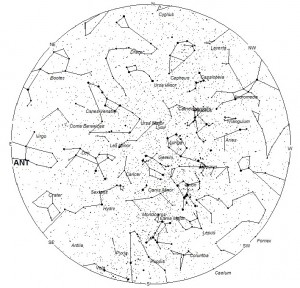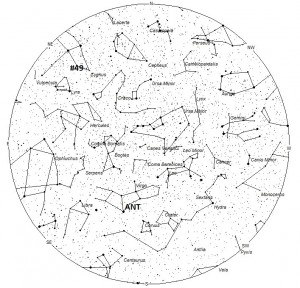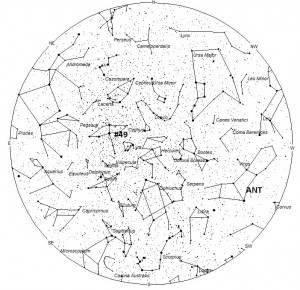During this period the moon reaches its full phase on Wednesday March 27th. At this time the moon is located opposite the sun and will be above the horizon the entire night. This weekend the waxing gibbous moon will set during the late morning hours, allowing a short period of dark skies between moon set and the start of morning twilight. The estimated total hourly meteor rates for evening observers this week is near two as seen from the northern hemisphere and three as seen from south of the equator. For morning observers the estimated total hourly rates should be near five from the mid-northern hemisphere and seven from the mid-southern hemisphere. The actual rates will also depend on factors such as personal light and motion perception, local weather conditions, alertness and experience in watching meteor activity. Rates are reduced during this period due to interfering moonlight.
The radiant (the area of the sky where meteors appear to shoot from) positions and rates listed below are exact for Saturday night/Sunday morning March 23/24. These positions do not change greatly day to day so the listed coordinates may be used during this entire period. Most star atlases (available at science stores and planetariums) will provide maps with grid lines of the celestial coordinates so that you may find out exactly where these positions are located in the sky. A planisphere or computer planetarium program is also useful in showing the sky at any time of night on any date of the year. Activity from each radiant is best seen when it is positioned highest in the sky, either due north or south along the meridian, depending on your latitude. It must be remembered that meteor activity is rarely seen at the radiant position. Rather they shoot outwards from the radiant so it is best to center your field of view so that the radiant lies at the edge and not the center. Viewing there will allow you to easily trace the path of each meteor back to the radiant (if it is a shower member) or in another direction if it is a sporadic. Meteor activity is not seen from radiants that are located below the horizon. The positions below are listed in a west to east manner in order of right ascension (celestial longitude). The positions listed first are located further west therefore are accessible earlier in the night while those listed further down the list rise later in the night.
The following showers are expected to be active this week:
The large Anthelion (ANT) radiant is currently located at 13:04 (196) -07. This position lies in central Virgo, five degrees northwest of the first magnitude star Spica (Alpha Virginis). These meteors may be seen all night long but the radiant is best placed near 0200 Local Daylight Time (LDT) when it lies on the meridian and is highest in the sky. Rates at this time should be near two per hour no matter your location. With an entry velocity of 30 km/sec., the average Antihelion meteor would be of slow velocity.
IMO #49 is an unnamed shower active between March 22 and April 7. The radiant is currently located at 19:28 (292) +42. This position lies on the Lyra-Cygnus border, directly between the bright stars Vega and Deneb. Rates are expected to be exceedingly low this week no matter your location. Your best chance to catch this activity would be near April 3rd when it briefly becomes the strongest radiant in the sky. The radiant is best placed in a dark sky just before dawn. At 45km/sec. this shower would produce meteors of medium velocity.
As seen from the mid-northern hemisphere (45N) one would expect to see approximately three sporadic meteors per hour during the last hour before dawn as seen from rural observing sites. Evening rates would be near one per hour. As seen from the mid-southern hemisphere (45S), morning rates would be near five per hour as seen from rural observing sites and two per hour during the evening hours. Locations between these two extremes would see activity between the listed figures. Rates are reduced during this period due to moonlight.
The table below presents a condensed version of the expected activity this week. Rates and positions are exact for Saturday night/Sunday morning .
| SHOWER | DATE OF MAXIMUM ACTIVITY | CELESTIAL POSITION | ENTRY VELOCITY | CULMINATION | HOURLY RATE | CLASS |
| RA (RA in Deg.) DEC | Km/Sec | Local Daylight Time | North-South | |||
| Anthelions (ANT) | – | 13:04 (196) -07 | 30 | 02:00 | 2 – 2 | II |
| IMO #49 | Apr 03 | 19:28 (292) +42 | 45 | 08:00 | <1 – <1 | IV |
 American Meteor Society
American Meteor Society



I saw a meteor tonight! I was driving home around 8:00 pm this evening and saw a bright green meteor (from inside the vehicle it did appear to be about the size of a basketball in the sky) it was VERY noticeable with a nice long white tail it was beautiful! (I live on the eastern shore of Maryland) This will sound odd but, it suddenly appeared and moved fast across the sky and then died out (it almost seemed to move fast but, slow at same time if that makes sense).
Just thought someone would like to know 🙂
My dad came home around 8:30 yesterday bragging to me that he saw a beautiful, bright, slow meteorite. He lives in South Florida.
We were traveling from Massachusetts to Pennsylvania on Interstate 87 in NY state Friday evening, 3/22/13, and saw the exact same “thing” as Lauren Shilling did. From our perspective this meteorite traveled horizontally from right to left with the same long white tail at a much faster speed than would a jet and we saw it disappear into a huge black cloud which caused several spectacular bursts of lightning-type activity before completely disappearing from view. We wondered if anyone had seen this amazing thing. Curious to know if anyone found fragments on the ground and where. So much in our amazing God-created Universe to explore!!!